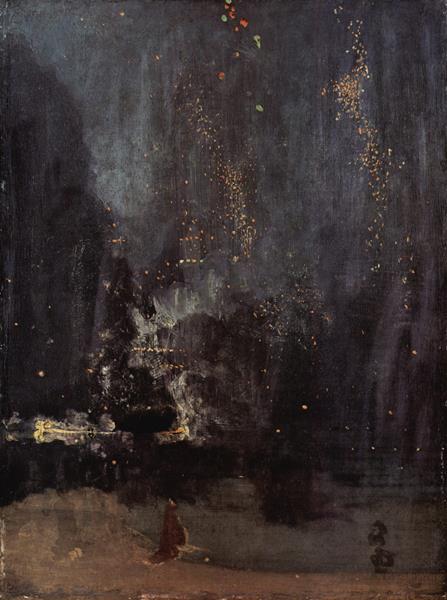The Road to Abstraction: An Outline
 |
| Whistler, Nocturne in Black and Gold, 1875 |
Took the opportunity of having free time this holiday weekend to peruse Susie Hodge's excellent Art in Detail: 100 Masterpieces. Seeing a select group of influential European and American pieces laid out chronologically made it easy to detect the main contours in the, um, not development, but journey of painting in the West. As I engaged with the book, I started mapping in my mind what the road to abstraction looked like. Thought I would write some of it down here before I forgot what it was that struck me as interesting at the time. This list is hardly all inclusive. It's just based on works Hodge included in the book. But I think the sense of it is good.
J.M.W. Turner (c. 1840s): By focusing on the the interplay of rain and sun with the steam emanating from the trains that were novel at the time, he essentially created vast areas of abstract color and form. In fact, the train itself is frequently presented as almost incidental to the scene, which for all intents and purposes is fully abstract. A traditionally figurative painter might reverse things, focusing on the engineering marvel of the train with the steam as an afterthought. With Turner as with other 19th century painters to follow, the works are not "pure" abstracts, since they portray images of abstraction that occur in real life.
Claude Monet (c. 1870s): Monet, of course achieved his purest expressions of abstraction in the presentation of bodies of water, including his pond. I'm not sure the extent to which Monet is abstracting what his eye sees, but his focus is presenting what appears to the eye in differing conditions of light. This is why when you think impressionist, you think Monet. I must admit I am tired of his aesthetic, whether through overexposure or because I just don't like it (too pretty), but there's no denying how he championed color as the sine qua non of painting.
James Abbott McNeill Whistler (c 1870s): Influenced by Japanese aesthetics, Whistler is the one who seems most fully devoted to abstraction as the key meaning or intent of his pieces. Notably, he titled his works as if they were musical compositions. Even the figurative masterpiece known as "Whistler's Mother" was actually titled "Arrangement in Grey and Black, No. 1." Dear old mom is just there for the visual information she provides! I probably like Whistler the best of these 19th century proto-abstractionists. Just a quick note: Figurative painters have always included elements of abstraction in their works, say, the way a scarf or curtain or piece of clothing, or maybe some silver, is treated loosely, but the artists I'm presenting here foreground the abstraction.
Edvard Munch (c. 1890s): I'm going to include "The Scream" here, because it's just nominally figurative, since the central figure and the landscape aren't realistic in any sense, portraying through line and color the intense emotion of the painting. People like van Gogh picked up on the extreme use of vibrant color, and the wavy look, but the works are always representational.
Wassily Kandinsky (early 20th cent.): Now we move to pure abstraction. A leading figure and thinker of the creation of "non-objective" art, Kandinsky was explicitly influenced by Theosophy, the movement of occult and esoteric spirituality that drew heavily from Hinduism and the mystical strains of all the world's religions, to endeavor the creation of a new world spirituality. It's the foundation for everything we now know as New Age or alternative spirituality, as well as secular bohemian manifestations, for example The Grateful Dead. Kandinsky's idea was that art could best portray realities that undergird what we know as physical reality. As an aside, we should mention Hilma af Klint here (not in Hodge's book), who also worked the Theosophy angle, with large, gorgeous, geometrically-informed abstracts, but whose work was not seen at the time (late 19th early 20th century), due to her wishes.
Kazimir Malevich (c. 1910s): I posted earlier this year on Malevich, who cut ties with the perceptual "real" world more boldly than anyone to date. His movement to pure geometry nodded to Platonic ideals, and he was firm in his conviction that form and color were better vehicles for emotion and spirituality than figurative works, even if those figurative works were showing people grieving or weeping or rejoicing. He even moved art toward the conceptual realm with his painting "Black Square on White Ground."
I'll wind up the "road to" thoughts here. Soon full blown abstraction was everywhere. Think Miro and Mondrian, and on and on. When the Guggenheim Museum was founded in 1939, it actually was called the Museum of Non-Objective Painting. As readers of this site will know, I hesitate to speak of art in terms of "progress," but it was certainly true that at that time fully abstract art was a new thing in Western (non-indigenous) culture. By the 40s and 50s abstract painting, including abstract expressionism, became America's foremost expression in the visual arts, offering a visual corollary to jazz, America's greatest artist achievement. It continues today, but only as one mode of expression among many. But it will always be my favorite, the mode that makes my heart sing and my synapses fire.
Comments
Post a Comment